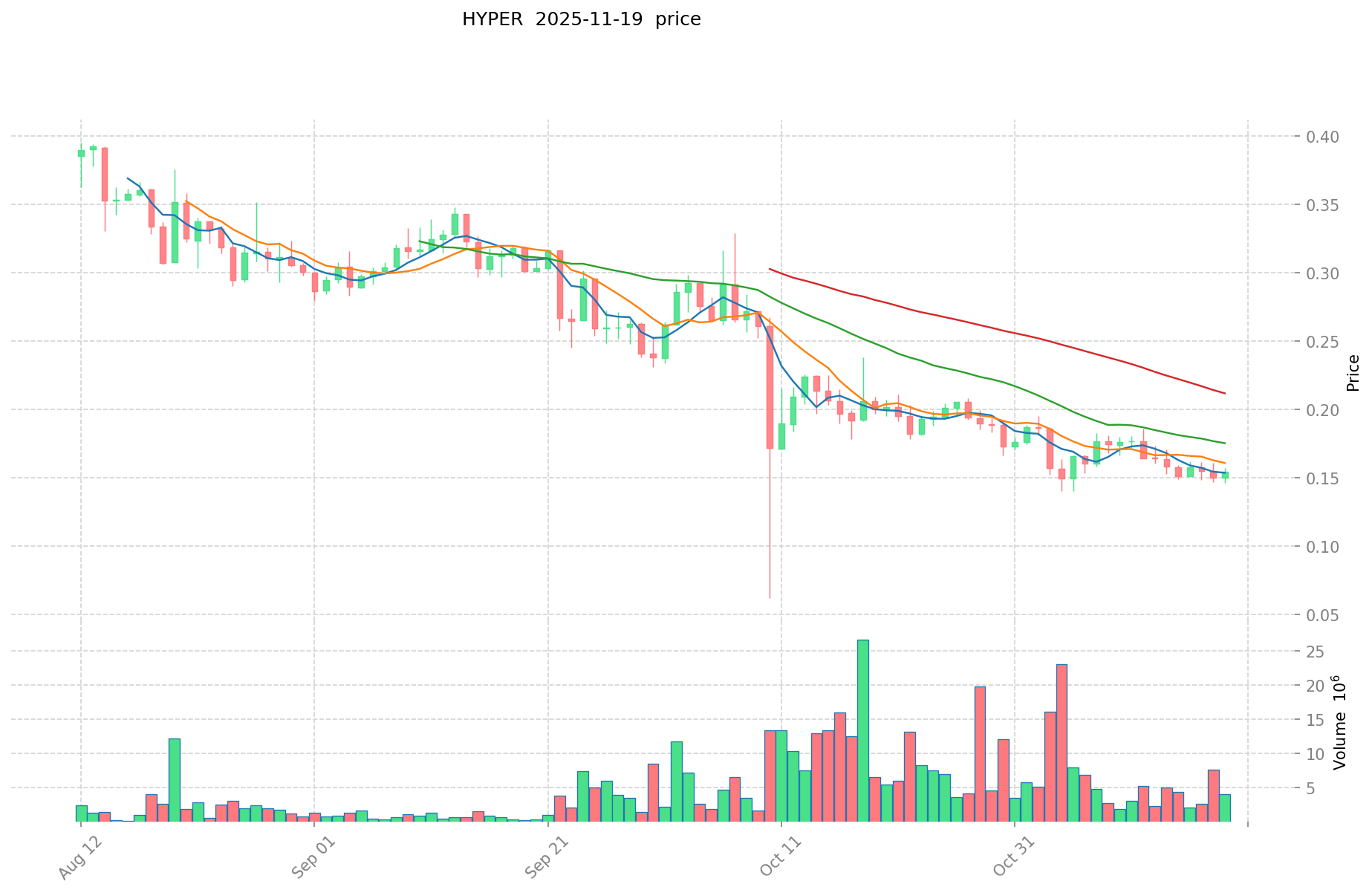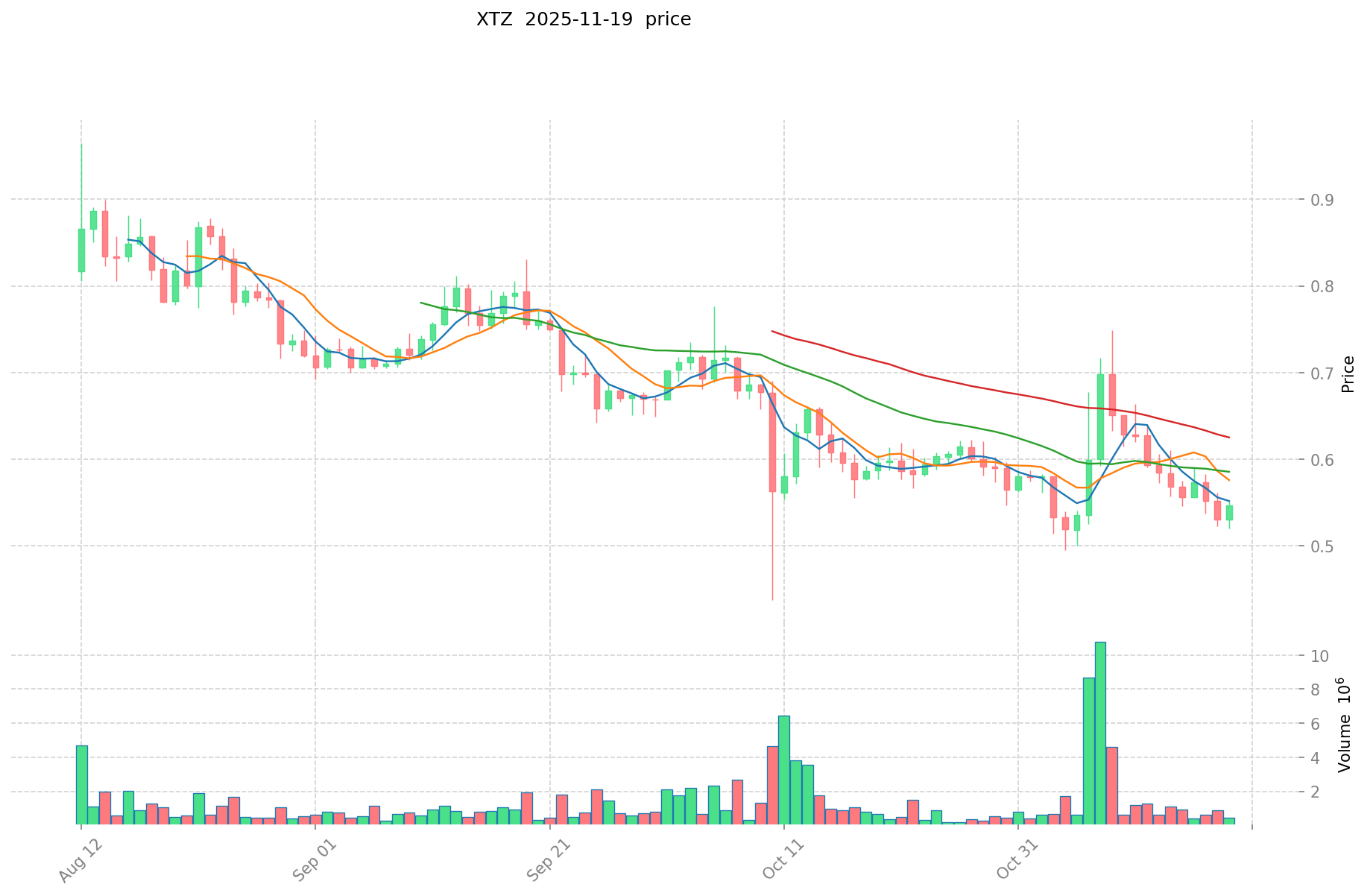HYPER vs XTZ: A Comparative Analysis of Two Emerging Cryptocurrencies in the DeFi Space
Introduction: Investment Comparison of HYPER vs XTZ
In the cryptocurrency market, the comparison between Hyperlane (HYPER) vs Tezos (XTZ) has always been a topic that investors cannot avoid. The two not only have significant differences in market cap ranking, application scenarios, and price performance, but also represent different positioning in crypto assets.
Hyperlane (HYPER): Since its launch, it has gained market recognition for its positioning as "The Open Interoperability Framework" for cross-chain communication.
Tezos (XTZ): Launched in 2017, it has been hailed as a self-evolving blockchain platform, and is one of the cryptocurrencies with high global trading volume and market capitalization.
This article will comprehensively analyze the investment value comparison between HYPER and XTZ, focusing on historical price trends, supply mechanisms, institutional adoption, technical ecosystems, and future predictions, and attempt to answer the question that investors are most concerned about:
"Which is the better buy right now?"
I. Price History Comparison and Current Market Status
HYPER (Coin A) and XTZ (Coin B) Historical Price Trends
- 2025: HYPER reached its all-time high of $0.68762 on July 11, 2025, and its all-time low of $0.06181 on October 10, 2025.
- 2021: XTZ reached its all-time high of $9.12 on October 4, 2021.
- Comparative analysis: In the recent market cycle, HYPER experienced significant volatility, dropping from its peak to its lowest point within a few months in 2025. XTZ, on the other hand, has been on a longer-term downtrend since its 2021 peak, currently trading at a much lower price compared to its all-time high.
Current Market Situation (2025-11-19)
- HYPER current price: $0.15003
- XTZ current price: $0.5352
- 24-hour trading volume: HYPER $650,543.42 vs XTZ $259,583.05
- Market Sentiment Index (Fear & Greed Index): 15 (Extreme Fear)
Click to view real-time prices:
- View HYPER current price Market Price
- View XTZ current price Market Price


II. Core Factors Affecting Investment Value of HYPER vs XTZ
Supply Mechanism Comparison (Tokenomics)
- HYPER: Deflationary model with burn mechanism and decreasing supply
- XTZ (Tezos): Inflationary model with new tokens created through baking (staking)
- 📌 Historical Pattern: Deflationary assets like HYPER tend to appreciate in value during bull markets while XTZ's inflation may create selling pressure unless offset by sufficient demand.
Institutional Adoption and Market Applications
- Institutional Holdings: XTZ has more established institutional presence with Coinbase Custody and other services supporting it
- Enterprise Adoption: XTZ has partnerships in various sectors including banking, real estate, and gaming, while HYPER is newer to the institutional market
- Regulatory Attitudes: XTZ has navigated regulatory environments successfully in multiple jurisdictions; HYPER's regulatory standing is less established
Technical Development and Ecosystem Building
- HYPER Technical Upgrades: Building out cross-chain functionality and interoperability features
- XTZ Technical Development: Ongoing protocol improvements through on-chain governance and regular upgrades
- Ecosystem Comparison: XTZ has a more mature ecosystem with established DeFi protocols, NFT marketplaces, and enterprise solutions; HYPER's ecosystem is in earlier development stages
Macroeconomic Factors and Market Cycles
- Performance in Inflationary Environments: HYPER's deflationary model potentially provides better inflation hedge properties
- Macroeconomic Monetary Policy: Both assets affected by broader crypto market reactions to interest rates and USD strength
- Geopolitical Factors: XTZ's established position in multiple countries provides greater resilience to regional regulatory changes
III. 2025-2030 Price Prediction: HYPER vs XTZ
Short-term Prediction (2025)
- HYPER: Conservative $0.1392 - $0.1497 | Optimistic $0.1497 - $0.1782
- XTZ: Conservative $0.4868 - $0.5350 | Optimistic $0.5350 - $0.5885
Mid-term Prediction (2027)
- HYPER may enter a growth phase, with prices estimated between $0.1780 - $0.2538
- XTZ may enter a steady phase, with prices estimated between $0.5193 - $0.6340
- Key drivers: Institutional capital inflow, ETF, ecosystem development
Long-term Prediction (2030)
- HYPER: Base scenario $0.2613 - $0.2979 | Optimistic scenario $0.2979 - $0.3276
- XTZ: Base scenario $0.7766 - $1.1261 | Optimistic scenario $1.1261 - $1.2387
Disclaimer: This analysis is based on historical data and projections. Cryptocurrency markets are highly volatile and unpredictable. This information should not be considered as financial advice. Always conduct your own research before making investment decisions.
HYPER:
| 年份 | 预测最高价 | 预测平均价格 | 预测最低价 | 涨跌幅 |
|---|---|---|---|---|
| 2025 | 0.1782144 | 0.14976 | 0.1392768 | 0 |
| 2026 | 0.214823232 | 0.1639872 | 0.10659168 | 9 |
| 2027 | 0.25380298944 | 0.189405216 | 0.17804090304 | 26 |
| 2028 | 0.2349003488832 | 0.22160410272 | 0.2060918155296 | 48 |
| 2029 | 0.294445371284064 | 0.2282522258016 | 0.155211513545088 | 52 |
| 2030 | 0.297937630338828 | 0.261348798542832 | 0.16987671905284 | 74 |
XTZ:
| 年份 | 预测最高价 | 预测平均价格 | 预测最低价 | 涨跌幅 |
|---|---|---|---|---|
| 2025 | 0.5885 | 0.535 | 0.48685 | 0 |
| 2026 | 0.6460125 | 0.56175 | 0.4887225 | 4 |
| 2027 | 0.6340753125 | 0.60388125 | 0.519337875 | 12 |
| 2028 | 0.8603798109375 | 0.61897828125 | 0.359007403125 | 15 |
| 2029 | 0.813646950703125 | 0.73967904609375 | 0.62133039871875 | 38 |
| 2030 | 1.126161347677734 | 0.776662998398437 | 0.528130838910937 | 45 |
IV. Investment Strategy Comparison: HYPER vs XTZ
Long-term vs Short-term Investment Strategy
- HYPER: Suitable for investors focused on cross-chain interoperability and ecosystem growth potential
- XTZ: Suitable for investors seeking established platforms with ongoing development and institutional adoption
Risk Management and Asset Allocation
- Conservative investors: HYPER 20% vs XTZ 80%
- Aggressive investors: HYPER 60% vs XTZ 40%
- Hedging tools: Stablecoin allocation, options, cross-currency portfolios
V. Potential Risk Comparison
Market Risk
- HYPER: Higher volatility due to newer market entry and smaller market cap
- XTZ: Potential for extended periods of price stagnation in bear markets
Technical Risk
- HYPER: Scalability challenges, network stability during rapid growth
- XTZ: Governance risks, potential for contentious upgrades
Regulatory Risk
- Global regulatory policies may affect both differently, with XTZ potentially having an advantage due to its more established presence
VI. Conclusion: Which Is the Better Buy?
📌 Investment Value Summary:
- HYPER advantages: Deflationary model, cross-chain interoperability focus, potential for higher growth
- XTZ advantages: Established ecosystem, institutional adoption, proven track record of upgrades
✅ Investment Advice:
- New investors: Consider a higher allocation to XTZ for its established position and lower volatility
- Experienced investors: Balanced approach with both HYPER and XTZ, adjusting based on risk tolerance
- Institutional investors: XTZ for its regulatory clarity and institutional services, with potential small allocation to HYPER for exposure to interoperability trends
⚠️ Risk Warning: The cryptocurrency market is highly volatile, and this article does not constitute investment advice. None
FAQ
Q1: What are the main differences between HYPER and XTZ? A: HYPER is a newer cryptocurrency focused on cross-chain interoperability with a deflationary model, while XTZ is an established platform with a more mature ecosystem and an inflationary model. HYPER has higher volatility and potential for growth, while XTZ offers more stability and institutional adoption.
Q2: Which coin has performed better historically? A: XTZ reached its all-time high of $9.12 in October 2021, while HYPER's all-time high was $0.68762 in July 2025. However, both have experienced significant price decreases since their peaks. XTZ has a longer track record, while HYPER is relatively new to the market.
Q3: How do the supply mechanisms of HYPER and XTZ differ? A: HYPER uses a deflationary model with a burn mechanism and decreasing supply, which can potentially lead to price appreciation. XTZ, on the other hand, has an inflationary model where new tokens are created through baking (staking).
Q4: What are the predictions for HYPER and XTZ prices in 2030? A: For HYPER, the base scenario predicts a range of $0.2613 - $0.2979, with an optimistic scenario of $0.2979 - $0.3276. For XTZ, the base scenario predicts $0.7766 - $1.1261, with an optimistic scenario of $1.1261 - $1.2387.
Q5: How should investors allocate their portfolio between HYPER and XTZ? A: Conservative investors might consider allocating 20% to HYPER and 80% to XTZ, while aggressive investors might opt for 60% HYPER and 40% XTZ. The allocation should be based on individual risk tolerance and investment goals.
Q6: What are the main risks associated with investing in HYPER and XTZ? A: HYPER faces higher volatility and technical risks due to its newer status and smaller market cap. XTZ may experience extended periods of price stagnation in bear markets and faces potential governance risks. Both are subject to regulatory risks, though XTZ may have an advantage due to its more established presence.
Q7: Which coin is better suited for institutional investors? A: XTZ is generally better suited for institutional investors due to its regulatory clarity, established institutional services like Coinbase Custody, and proven track record of upgrades. However, some institutions might consider a small allocation to HYPER for exposure to interoperability trends.
Share
Content